Pre-Alpine Tectono-Stratigraphic Reconstruction of the Jurassic Tethys in the High-Pressure Internal Piedmont Zone (Stura di Viù Valley, Western Alps)
Abstract
1. Introduction
2. Regional Geological Setting of the Western Alps
3. Methods
4. Lithostratigraphy of the IPZ
5. Alpine Structural Evolution
6. Discussion
6.1. The Intra-Oceanic Stratigraphy of the IPZ Metaophiolite
6.2. Reconstruction of the Intra-Oceanic Seafloor Physiography
7. Conclusions
Supplementary Materials
Author Contributions
Funding
Institutional Review Board Statement
Informed Consent Statement
Data Availability Statement
Acknowledgments
Conflicts of Interest
References
- Cannat, M. Emplacement of mantle rocks in the seafloor at mid-ocean ridges. J. Geophys. Res. Solid Earth 1993, 98, 4163–4172. [Google Scholar] [CrossRef]
- Karson, J.; Lawrence, R. Tectonic setting of serpentinite exposures on the western median valley wall of the MARK Area in the vicinity of Site 920. In Proceedings of the Ocean Drilling Program, Scientific Results; Karson, J.A., Cannat, M., Miller, D.J., Elthon, D., Eds.; Texas A&M University: College Station, TX, USA, 1997; Volume 153, pp. 5–22. [Google Scholar]
- Tucholke, B.; Lin, J.; Kleinrock, M. Megamullions and mullion structure defining oceanic metamorphic core complexes on the Mid-Atlantic Ridge. J. Geophys. Res. Solid Earth 1998, 103, 9857–9866. [Google Scholar] [CrossRef]
- MacLeod, C.; Searle, R.; Murtonc, B.; Casey, J.; Mallows, C.; Unsworth, S.; Achenbach, K.; Harris, M. Life cycle of oceanic core complexes. Earth Planet. Sci. Lett. 2009, 287, 333–344. [Google Scholar] [CrossRef]
- Manatschal, G.; Sauter, D.; Karpoff, A.; Masini, E.; Mohn, G.; Lagabrielle, Y. The Chenaillet Ophiolite in the French/Italian Alps: An ancient analogue for an Oceanic Core Complex? Lithos 2011, 124, 3–4. [Google Scholar] [CrossRef]
- Escartín, J.; Mével, C. Tectonic structure, evolution, and the nature of oceanic core complexes and their detachment fault zones (13°20′ N and 13°30′ N, Mid Atlantic Ridge). Geochem. Geophys. Geosyst. 2017, 18, 1451–1482. [Google Scholar] [CrossRef]
- Balestro, G.; Festa, A.; Dilek, Y. Structural architecture of the Western Alpine Ophiolites, and the Jurassic seafloor spreading tectonics of the Alpine Tethys. J. Geol. Soc. 2019, 176, 913–930. [Google Scholar] [CrossRef]
- Varga, R.; Moores, E. Spreading structure of the Troodos ophiolite, Cyprus. Geology 1985, 13, 846–850. [Google Scholar] [CrossRef]
- Lemoine, M.; Tricart, P.; Boillot, G. Ultramafic and gabbroic ocean floor of the Ligurian Tethys (Alps, Corsica, Apennines): In search of a genetic model. Geology 1987, 15, 622–625. [Google Scholar] [CrossRef]
- Harper, G. Episodic magma chambers and amagmatic extension in the Josephine ophiolite. Geology 1988, 16, 831–834. [Google Scholar] [CrossRef]
- Froitzheim, N.; Gregor, E. Extensional detachment faulting in the evolution of a Tethys passive continental margin, Eastern Alps, Switzerland. Geol. Soc. Am. Bull. Front. 1990, 102, 1297–1308. [Google Scholar] [CrossRef]
- Dilek, Y.; Eddy, C. The Troodos (Cyprus) and Kizildag (S. Turkey) Ophiolites as Structural Models for Slow-Spreading Ridge Segments. J. Geol. 1992, 100, 305–322. [Google Scholar] [CrossRef]
- Lagabrielle, Y. Ophiolites of the southwestern Alps and the structure of the Tethyan oceanic lithosphere. Ofioliti 1994, 19, 413–434. [Google Scholar]
- Principi, G.; Bortolotti, V.; Chiari, M.; Cortesogno, L.; Gaggero, L.; Marcucci, M.; Saccani, E.; Treves, B. The pre-orogenic volcano-sedimentary covers of the western Tethys oceanic basin: A review. Ofioliti 2004, 29, 177–211. [Google Scholar]
- Balestro, G.; Lombardo, B.; Vaggelli, G.; Borghi, A.; Festa, A.; Gattiglio, M. Tectonostratigraphy of the northern Monviso meta-ophiolite complex (Western Alps). Ital. J. Geosci. 2014, 133, 409–426. [Google Scholar] [CrossRef]
- Clerc, C.; Lagabrielle, Y. Thermal control on the modes of crustal thinning leading to mantle exhumation: Insights from the Cretaceous Pyrenean hot palaeomargins. Tectonics 2014, 33, 1340–1359. [Google Scholar] [CrossRef]
- Festa, A.; Balestro, G.; Borghi, A.; De Caroli, S.; Succo, A. The role of structural inheritance in continental break-up and exhumation of Alpine Tethyan mantle (Canavese Zone, Western Alps). Geosci. Front. 2020, 11, 167–188. [Google Scholar] [CrossRef]
- Lagabrielle, Y.; Asti, R.; Duretz, T.; Clerc, C.; Fourcade, S.; Teixell, A.; Labaume, P.; Corre, B.; Saspiturry, N. A review of Cretaceous smooth-slopes extensional basins along the Iberia-Eurasia plate boundary: How pre-rift salt controls the modes of continental rifting and mantle exhumation. Earth-Sci. Rev. 2020, 201, 103071. [Google Scholar] [CrossRef]
- Girardeau, J.; Mével, C. Amphibolitized sheared gabbros from ophiolites as indicators of the evolution of the oceanic crust: Bay of Islands, Newfoundland. Earth Planet. Sci. Lett. 1982, 61, 151–165. [Google Scholar] [CrossRef]
- Schroeder, T.; John, B.; Frost, B. Geologic implications of seawater circulation through peridotite exposed at slow-spreading mid-ocean ridges. Geology 2002, 30, 367–370. [Google Scholar] [CrossRef]
- Tartarotti, P.; Guerini, S.; Rotondo, F.; Festa, A.; Balestro, G.; Bebout, G.; Cannaò, E.; Epstein, G.; Scambelluri, M. Superposed sedimentary and tectonic block-in-matrix fabrics in a subducted serpentinite mélange (High-Pressure Zermatt Saas Ophiolite, Western Alps). Geosciences 2019, 9, 358. [Google Scholar] [CrossRef]
- Toth, J.; Gurnis, M. Dynamics of subduction initiation at preexisting fault zones. J. Geophys. Res. 1998, 103, 18053–18067. [Google Scholar] [CrossRef]
- Tommasi, A.; Vauchez, A. Continental rifting parallel to ancient collisional belts: An effect of the mechanical anisotropy of the lithospheric mantle. Earth Planet. Sci. Lett. 2001, 185, 199–210. [Google Scholar] [CrossRef]
- Hall, C.; Gurnis, M.; Sdrolias, M.; Lavier, L.; Muller, R. Catastrophic initiation of subduction following forced convergence across fracture zones. Earth Planet. Sci. Lett. 2003, 212, 15–30. [Google Scholar] [CrossRef]
- Leng, W.; Gurnis, M. Dynamics of subduction initiation with different evolutionary pathways. Geochem. Geophys. Geosyst. 2011, 12, Q12018. [Google Scholar] [CrossRef]
- Spalla, M.; Zanoni, D.; Marotta, A.; Rebay, G.; Roda, M.; Zucali, M.; Gosso, G. The transition from Variscan collision to continental break-up in the Alps: Insights from the comparison between natural data and numerical model predictions. In The Variscan Orogeny: Extent, Timescale and the Formation of the Europe; Schulmann, K., Martínez Catalán, J.R., Lardeaux, J.M., Janousek, V., Oggiano, G., Eds.; Geological Society, London, Special Publications: London, UK, 2014; Volume 405, pp. 363–400. [Google Scholar]
- Balestro, G.; Festa, A.; Borghi, A.; Castelli, D.; Tartarotti, P.; Gattiglio, M. Role of late Jurassic intra-oceanic structural inheritance in the Alpine tectonic evolution of the Monviso meta-ophiolite complex (Western Alps). Geol. Mag. 2018, 155, 233–249. [Google Scholar] [CrossRef]
- Marotta, A.; Roda, M.; Conte, K.; Spalla, M. Thermo-mechanical numerical model of the transition from continental rifting to oceanic spreading: The case study of the Alpine Tethys. Geol. Mag. 2018, 155, 250–279. [Google Scholar] [CrossRef]
- Roda, M.; Regorda, A.; Spalla, M.; Marotta, A. What drives Alpine Tethys opening? Clues from the review of geological data and model predictions. Geol. J. 2019, 54, 2646–2664. [Google Scholar] [CrossRef]
- Rotondo, F.; Tartarotti, P.; Guerini, S.; Della Porta, G.; Campomenosi, N. Metasomatic horizon sealing serpentinite-metasediments pair in the Zermatt-Saas metaophiolite (Northwestern Alps): Record of a channel for focused fluid flow during subduction. Ofioliti 2021, 46, 1–25. [Google Scholar]
- Balestro, G.; Festa, A.; Dilek, Y.; Tartarotti, P. Pre-Alpine Extensional Tectonics of a Peridotite-Localized Oceanic Core Complex in the Late Jurassic, High-Pressure Monviso ophiolite (Western Alps). Episodes 2015, 38, 266–282. [Google Scholar] [CrossRef]
- Nicolas, A. Le complexe Ophiolites-Schistes Lustrés entre Dora Maira et Grand Paradis (Alpés Piémontaises). Master’s Thesis, University of Grenoble, Grenoble, France, 1966; p. 299. [Google Scholar]
- Perotto, A.; Salino, C.; Pognante, U.; Genovese, G.; Gosso, G. Assetto geologico-strutturale della Falda Piemontese nel settore dell’alta Valle di Viù (Alpi occidentali). Mem. Della Soc. Geol. Ital. 1983, 26, 479–483. [Google Scholar]
- Bigi, G.; Cosentino, D.; Parotto, M.; Sartori, R.; Scandone, P. Structural Model of Italy (1:500.000), CNR-Progetto finalizzato geodinamica (1:500.000). Quad. Ric. Sci. 1990. Sheets I-II-III-IV. Available online: https://www.socgeol.it/438/structural-model-of-italy-scale-1-500-000.html (accessed on 26 February 2021).
- Ghignone, S.; Gattiglio, M.; Balestro, G.; Borghi, A. Geology of the Susa Shear Zone (Susa Valley, Western Alps). J. Maps 2020, 16, 1–8. [Google Scholar] [CrossRef]
- Ernst, W.; Dal Piaz, G. Mineral parageneses of eclogitic rocks and related mafic schists of the Piemonte ophiolite nappe, Breuil-St. Jacques area, Italian Western Alps. Am. Mineral. 1978, 63, 621–640. [Google Scholar]
- Lemoine, M.; Tricart, P. Les Schistes Lustrés piémontais des Alpes Occidentales: Approche stratigraphique, structurale et sédimentologique. Eclogae Geol. Helv. 1986, 79, 271–294. [Google Scholar]
- Vissers, R.; van Hinsbergen, D.; Meijer, P.; Piccardo, G. Kinematics of Jurassic ultra-slow spreading in the Piemonte Ligurian ocean. Earth Planet. Sci. Lett. 2013, 380, 138–150. [Google Scholar] [CrossRef]
- Lemoine, M. Données nouvelles sur la série du Gondran près Briançon (Alpes Cottiennes). Géol. Alp. 1971, 47, 181–201. [Google Scholar]
- Dal Piaz, G. Le métamorphisme de haute pression et basse température dans l’évolution structurale du bassin ophiolitique alpino-apenninique (2e partie). Schweiz. Mineral. Petrol. Mitteilungen 1974, 54, 399–424. [Google Scholar]
- Stampfli, G.M.; Borel, G.; Marchant, R.; Mosar, J. Western Alps geological constraints of western Tethyan reconstructions. J. Virtual Explor. 2002, 7, 75–104. [Google Scholar] [CrossRef]
- Rosenbaum, G.; Lister, G. The Western Alps from the Jurassic to Oligocene: Spatio-temporal constraints and evolutionary reconstructions. Earth-Sci. Rev. 2005, 69, 281–306. [Google Scholar] [CrossRef]
- Platt, J.; Behrmann, J.; Cunningham, P.; Dewey, J.; Helman, M.; Parish, M.; Shepley, M.; Wallis, S.; Western, P. Kinematics of the Alpine arc and the motion history of Adria. Nature 1989, 337, 158–161. [Google Scholar] [CrossRef]
- Polino, R.; Dal Piaz, G.; Gosso, G. Tectonic erosion at the Adria margin and acretionary processes for the Cretaceous orogeny in the Alps. In Deep Structure of the Alps; Roure, F., Heitzmann, P., Polino, R., Eds.; Société Géologique de France: Paris, France, 1990; Volume 1, pp. 345–367. [Google Scholar]
- Stampfli, G.; Marthaler, M. Divergent and convergent margins in the North-Western alps confrontation to actualistic models. Geodin. Acta 1990, 4, 159–184. [Google Scholar] [CrossRef]
- Steck, A.; Hunziker, J. The Tertiary structural and thermal evolution of the Central Alps—Compressional and extensional structures in an orogenic belt. Tectonophysics 1994, 238, 229–254. [Google Scholar] [CrossRef]
- Michard, A.; Goffè, B.; Chopin, C.; Henry, C. Did the Western Alps develop through an Oman-type stage? The geotectonic setting of high-pressure metamorphism in two contrasting Tethyan transects. Eclogae Geol. Helv. 1996, 89, 43–80. [Google Scholar]
- Dilek, Y. Collision tectonics of the Mediterranean region: Causes and consequences. Spec. Pap. Geol. Soc. Am. 2006, 409, 1. [Google Scholar]
- Butler, J.; Beaumont, C.; Jamieson, R. The Alps 1: A working geodynamic model for burial and exhumation of (ultra) high-pressure rocks in Alpine-type orogens. Earth Planet. Sci. Lett. 2013, 377, 114–131. [Google Scholar] [CrossRef]
- Ricou, L.; Siddans, W. Collision tectonics in the Western Alps. Geol. Soc. Lond. Spec. Publ. 1986, 19, 229–244. [Google Scholar] [CrossRef]
- Schmid, S.; Kissling, E.; Diehl, T.; Hinsbergen, D.; Molli, G. Ivrea mantle wedge, arc of the Western Alps, and kinematic evolution of the Alps-Apennines orogenic system. Swiss J. Geosci. 2017, 110, 581–612. [Google Scholar] [CrossRef]
- Tricart, P.; Lemoine, M. The Queyras ophiolite west of Monte Viso (Western Alps): Indicator of a peculiar ocean floor in the Mesozoic Tethys. J. Geodyn. 1991, 13, 163–181. [Google Scholar] [CrossRef]
- Martin, S.; Tartarotti, P.; Dal Piaz, G. Mesozoic ophiolites of the Alps: A review. Boll. Geofis. Teor. Appl. 1994, 36, 175–219. [Google Scholar]
- Tartarotti, P.; Festa, A.; Benciolini, L.; Balestro, G. Record of Jurassic mass transport processes through the orogenic cycle: Understanding chaotic rock units in the high-pressure Zermatt-Saas ophiolite (Western Alps). Lithosphere 2017, 9, 399–407. [Google Scholar] [CrossRef]
- Nicolas, A. Tectonique et métamorphisme dans les Stura di Lanzo (Alpes Occidentales). Schweiz. Mineral. Petrogr. Mitteilungen 1969, 49, 359–377. [Google Scholar]
- Spalla, M.; De Maria, L.; Gosso, G.; Miletto, M.; Pognante, U. Deformazione e metamorfismo della Zona Sesia-Lanzo meridionale al contatto con la Falda Piemontese e con il Massiccio di Lanzo, Alpi Occidentali. Mem. Della Soc. Geol. Ital. 1983, 26, 499–514. [Google Scholar]
- Lagabrielle, Y.; Fudral, S.; Kienast, J. La couverture océanique des ultrabasites de Lanzo (Alpes occidentales): Arguments lithostratigraphiques et pétrologiques. Geodin. Acta 1989, 3, 43–55. [Google Scholar] [CrossRef]
- Cadoppi, P.; Castelletto, M.; Sacchi, R.; Baggio, P.; Carraro, F.; Giraud, V. Carta Geologica d’Italia Alla Scala 1:50.000-Foglio 154 Susa e Note Illustrative; Servizio Geologico d’Italia: Roma, Italy, 2002; pp. 1–123. [Google Scholar]
- Balestro, G.; Cadoppi, P.; Perrone, G.; Tallone, S. Tectonic evolution along the Col del Lis-Trana Deformation Zone (internal Western Alps). Ital. J. Geosci. 2009, 128, 331–339. [Google Scholar]
- Gasco, I.; Gattiglio, M.; Borghi, A. Lithostratigraphic setting and P-T metamorphic evolution for the Dora Maira Massif along the Piedmont Zone boundary (middle Susa Valley, NW Alps). Int. J. Earth Sci. 2011, 100, 1065–1085. [Google Scholar] [CrossRef]
- Ghignone, S.; Borghi, A.; Balestro, G.; Castelli, D.; Gattiglio, M.; Groppo, C. HP-tectono-metamorphic evolution of the Internal Piedmont Zone in Susa Valley (Western Alps): New petrologic insight from garnet+chloritoid –bearing micaschists and Fe-Ti metagabbro. J. Metamorph. Geol. 2020. [Google Scholar] [CrossRef]
- Sandrone, R.; Leardi, L.; Rossetti, P.; Compagnoni, R. P-T conditions for the eclogitic re-equilibration of the metaophiolites from Val d’Ala di Lanzo (internal Piemontese zone, Western Alps). J. Metamorph. Geol. 1986, 4, 161–178. [Google Scholar] [CrossRef]
- Agard, P.; Monié, P.; Jolivet, L.; Goffé, B. In situ laser probe 40Ar-39Ar dating of the Schistes Lustrés complex: Implications for the exhumation of the Western Alps. J. Metamorph. Geol. 2002, 20, 599–618. [Google Scholar] [CrossRef]
- Lardeaux, J.; Schwartz, S.; Tricart, P.; Paul, A.; Guillot, S.; Béthoux, N.; Masson, F. A crustal-scale cross-section of the south-western Alps combining geophysical and geological imagery. Terra Nova 2006, 18, 412–422. [Google Scholar] [CrossRef]
- Ghignone, S.; Balestro, G.; Gattiglio, M.; Borghi, A. Structural evolution along the Susa Shear Zone: The role of a first-order shear zone in the exhumation of meta-ophiolite units (Western Alps). Swiss J. Geosci. 2020, 133, 17. [Google Scholar] [CrossRef]
- Gasco, I.; Gattiglio, M.; Borghi, A. Review of metamorphic and kinematic data from Internal Crystalline Massifs (Western Alps): PTt paths and exhumation history. J. Geodyn. 2013, 63, 1–19. [Google Scholar] [CrossRef]
- Butler, R.; Freeman, S. Can crustal extension be distinguished from thrusting in the internal parts of mountain belts? A case history of the Entrelor shear zone, Western Alps. J. Struct. Geol. 1996, 18, 909–923. [Google Scholar] [CrossRef]
- Malusà, M.; Polino, R.; Martin, S. The Gran San Bernardo nappe in the Aosta Valley (western Alps): A composite stack of distinct continental crust units. Bull. Soc. Géolo. Fr. 2005, 176, 417–431. [Google Scholar] [CrossRef]
- Festa, A.; Pini, G.; Ogata, K.; Dilek, Y. Diagnostic features and field-criteria in recognition of tectonic, sedimentary and diapiric mélanges in orogenic belts and exhumed subduction-accretion complexes. Gondwana Res. 2019, 74, 7–30. [Google Scholar] [CrossRef]
- Chalot-Prat, F.; Ganne, J.; Lombard, A. No significant element transfer from the oceanic plate to the mantle wedge during subduction and exhumation of the Tethys Ocean (Western Alps). Lithos 2003, 69, 69–103. [Google Scholar] [CrossRef]
- Piccardo, G. Evolution of the lithospheric mantle in an extensional setting: Insights from ophiolitic peridotites. Lithosphere 2009, 1, 81–87. [Google Scholar] [CrossRef]
- Driesner, T. Aspects of petrographical, structural and stable isotope geochemical evolution of ophicarbonate breccias from ocean floor to subduction and uplift; an example from Chatillon, Middle Aosta Valley, Italian Alps. Schweiz. Mineral. Petrogr. Mitteilungen 1993, 73, 69–84. [Google Scholar]
- Lafay, R.; Baumgartner, L.; Schwartz, S.; Picazo, S.; Montes-Hernandez, G.; Vannemann, T. Petrologic and stable isotopic studies of a fossil hydrothermal system in ultramafic environment (Chenaillet ophicalcites, Western Alps, France): Processes of carbonate cementation. Lithos 2017, 294–295, 319–338. [Google Scholar] [CrossRef]
- Decandia, F.; Elter, P. La zona ofiolitifera del Bracco nel settore compreso tra Levanto e la Val Graveglia (Appennino Ligure). Mem. Della Soc. Geol. Ital. 1972, 11, 503–530. [Google Scholar]
- Tricart, P. Tectoniques superposées dans les calcschistes piémontais du Haut-Cristillan (Queyras, Alpes franco-italiennes). C. R. Acad. Sci. 1973, 76, 705–708. [Google Scholar]
- Marroni, M.; Meneghini, F.; Pandolfi, L. Anatomy of the Ligure-Piemontese subduction system: Evidence from Late Cretaceous–middle Eocene convergent margin deposits in the Northern Apennines, Italy. Int. Geol. Rev. 2010, 52, 1160–1192. [Google Scholar] [CrossRef]
- Barbero, E.; Festa, A.; Saccani, E.; Catanzariti, R.; D’Onofrio, R. Redefinition of the Ligurian Units at the Alps-Apennines junction (NW Italy) and their role in the evolution of the Ligurian accretionary wedge: Constraints from mélanges and broken formations. J. Geol. Soc. 2020, 177, 562–574. [Google Scholar] [CrossRef]
- Elter, P.; Trevisan, L. Olistostromes in the tectonic evolution of the Northern Apennines. In Gravity and Tectonics; De Jong, K.A., Scholten, R., Eds.; John Willey and Sons: New York, NY, USA, 1973; Volume 1, pp. 175–188. [Google Scholar]
- Marroni, M.; Pandolfi, L. Debris flow and slide deposits at the top of the Internal Liguride ophiolitic sequence, Northern Apennines, Italy: A record of frontal tectonic erosion in a fossil accretionary wedge. Isl. Arc 2001, 10, 9–21. [Google Scholar] [CrossRef]
- Meneghini, F.; Pandolfi, L.; Marroni, M. Recycling of heterogeneous material in the subduction factory: Evidence from the sedimentary mélange of the Internal Ligurian Units, Italy. J. Geol. Soc. 2020, 177, 587–599. [Google Scholar] [CrossRef]
- Penrose Conference Participants. Penrose field conference on ophiolites. Geotimes 1972, 17, 24–25. [Google Scholar]
- Dilek, Y.; Furnes, H. Ophiolite genesis and global tectonics: Geochemical and tectonic fingerprinting of ancient oceanic lithosphere. Geol. Soc. Am. Bull. 2011, 123, 387–411. [Google Scholar] [CrossRef]
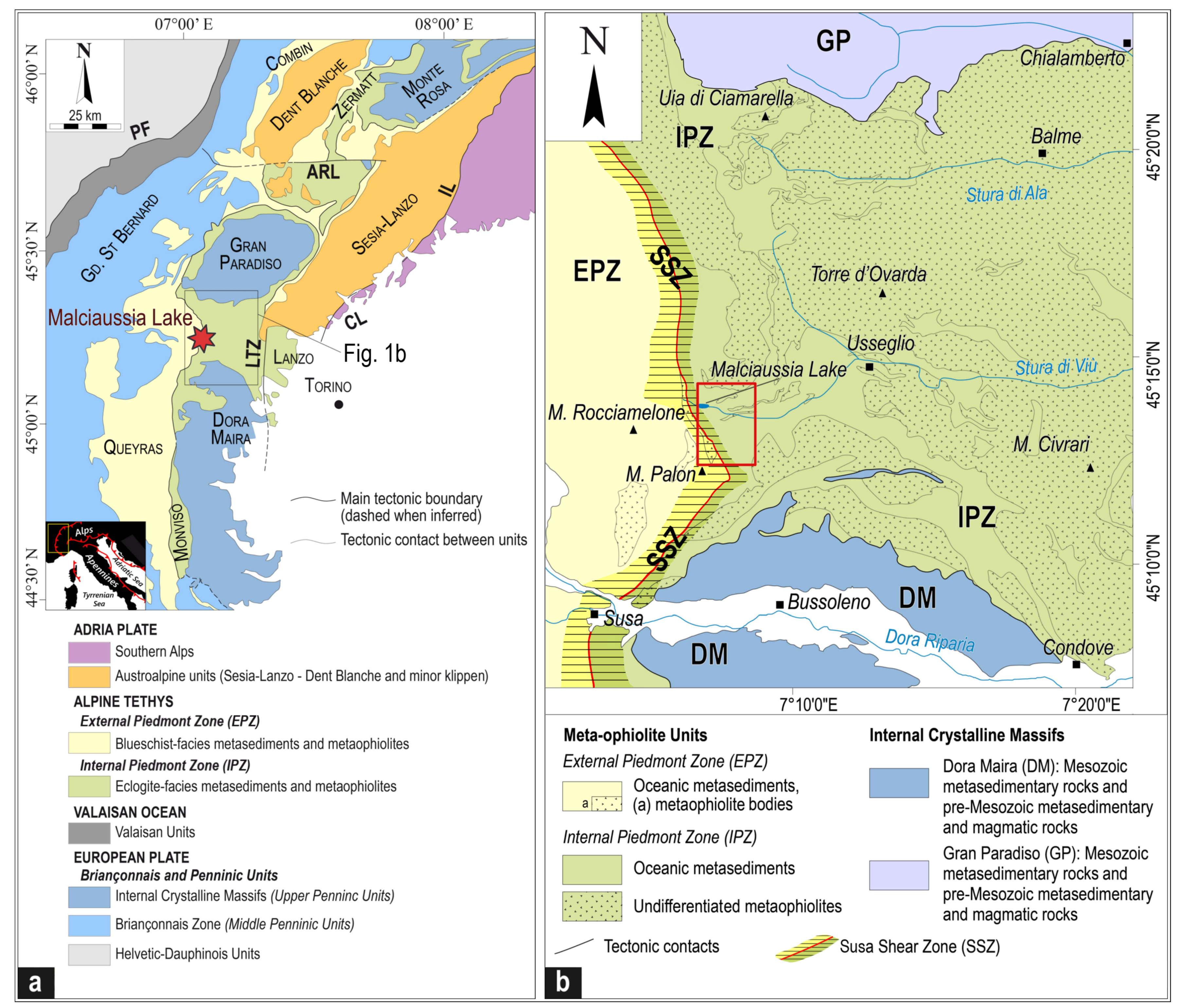
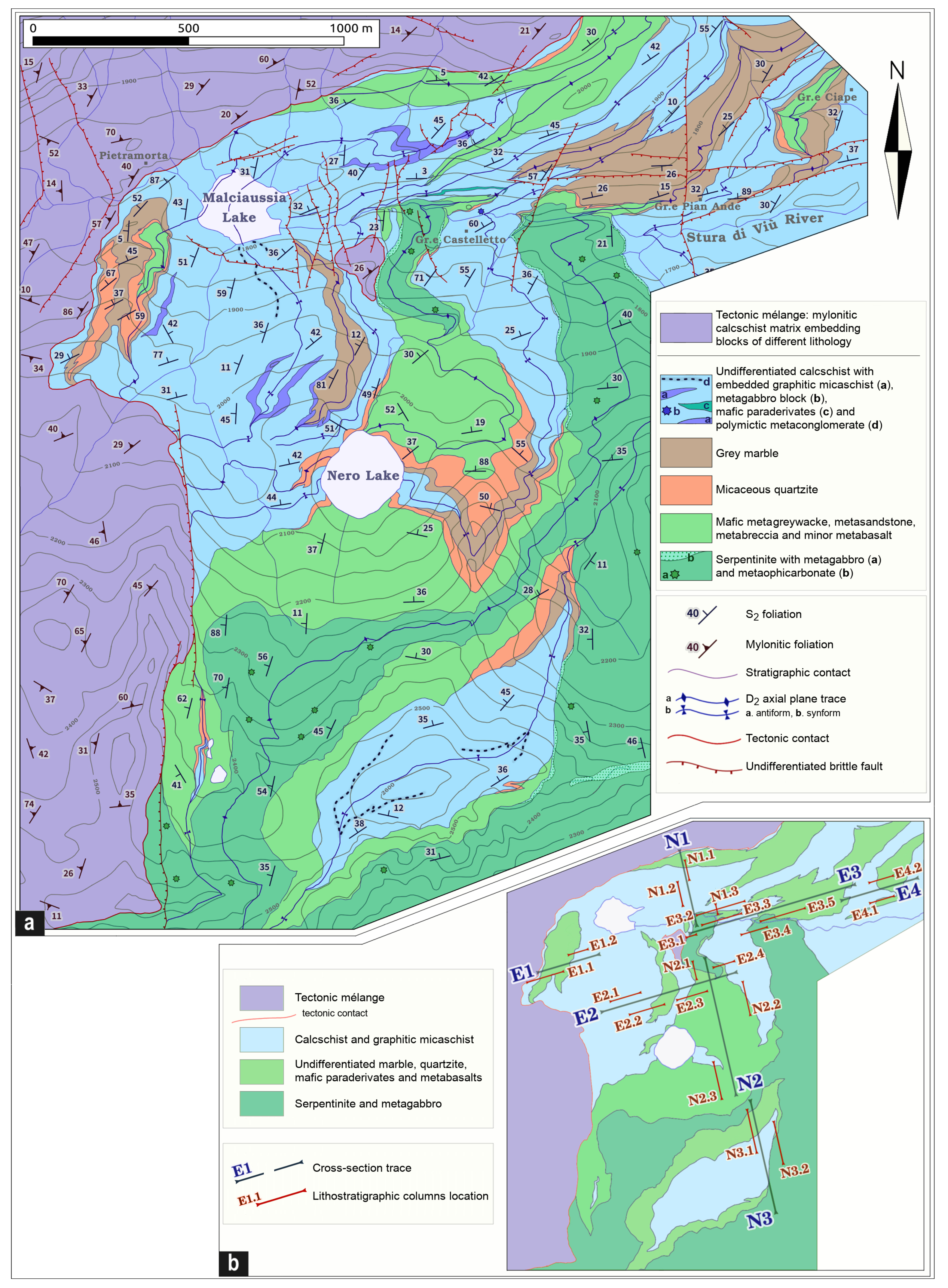


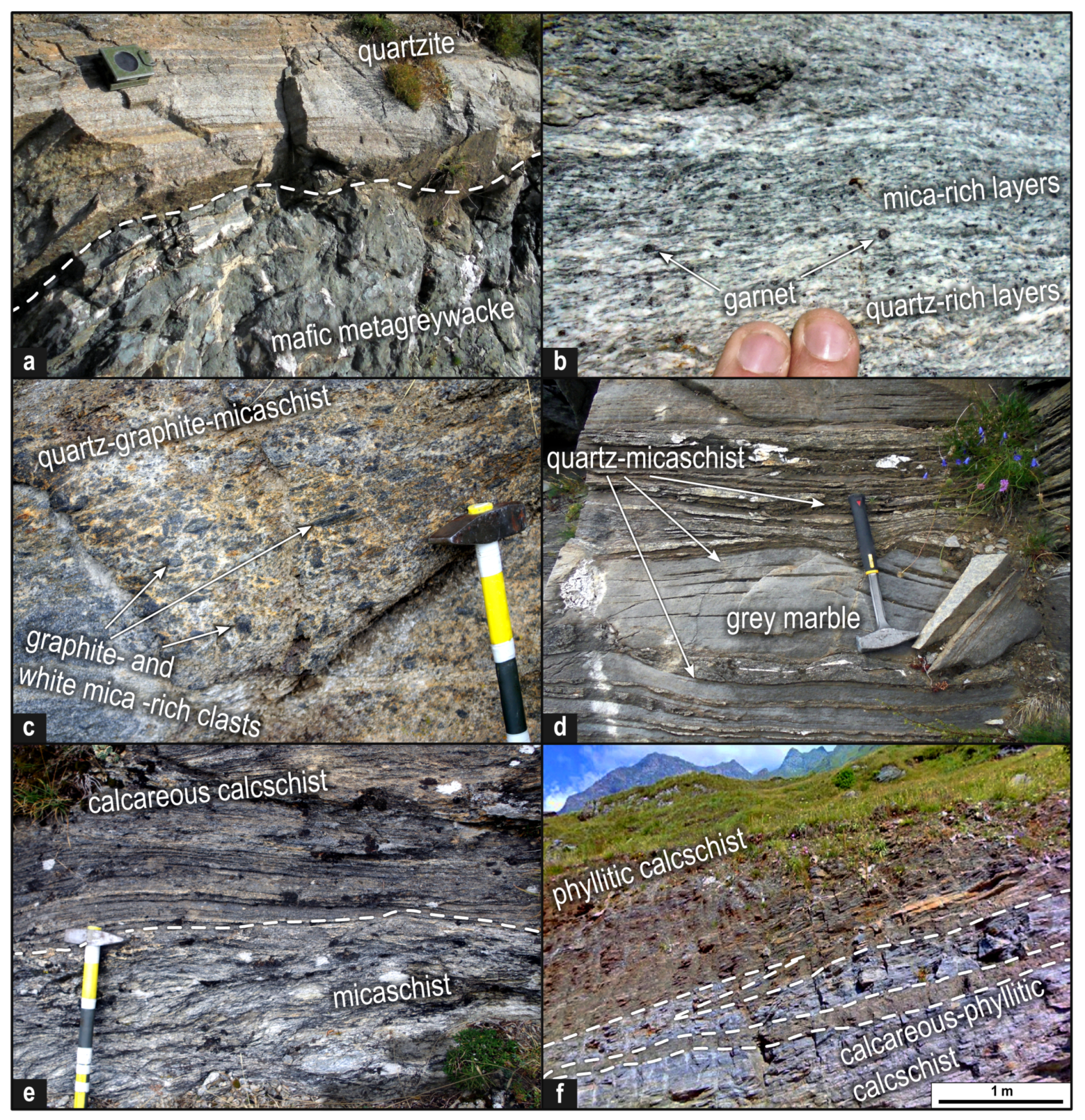
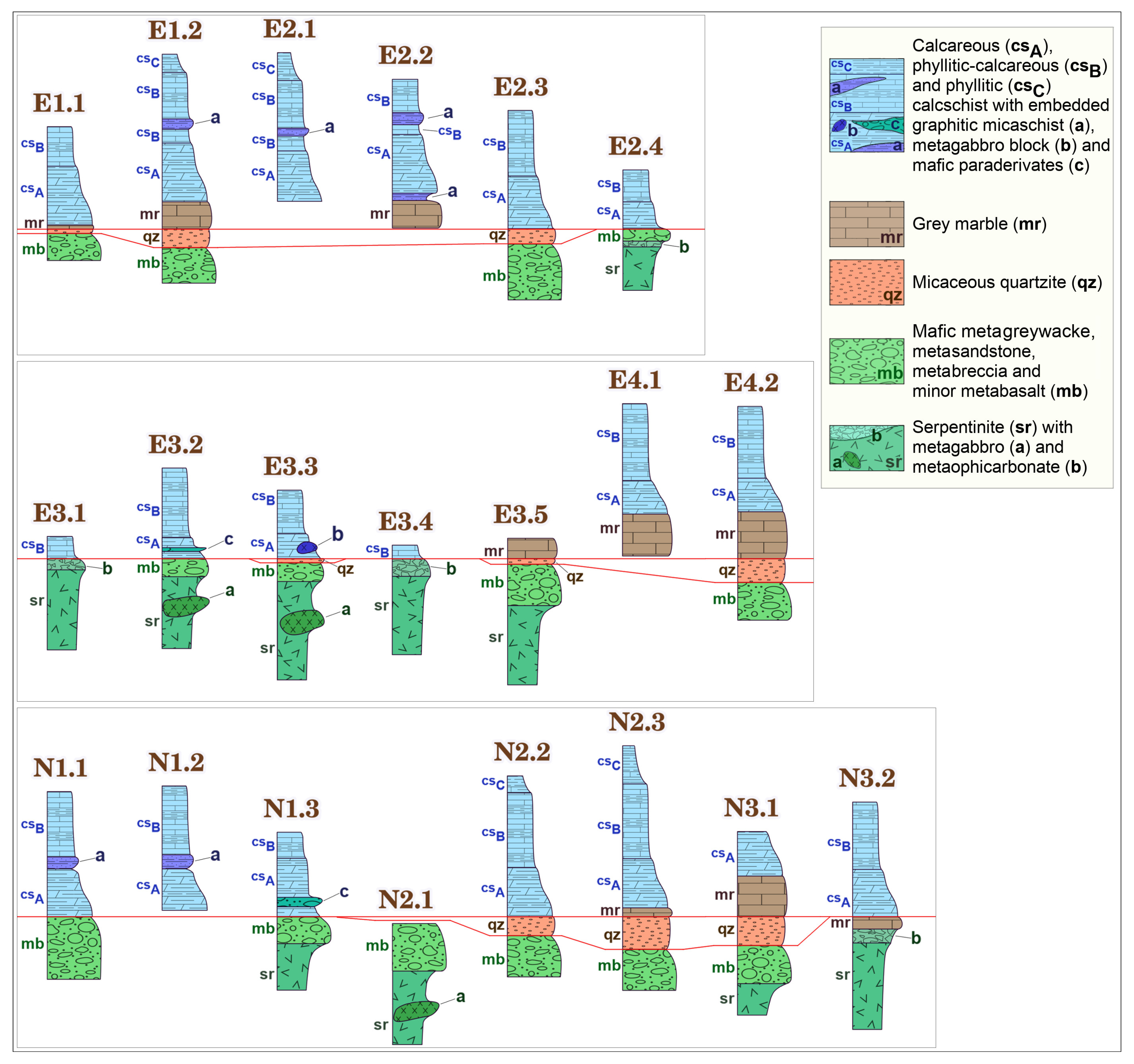

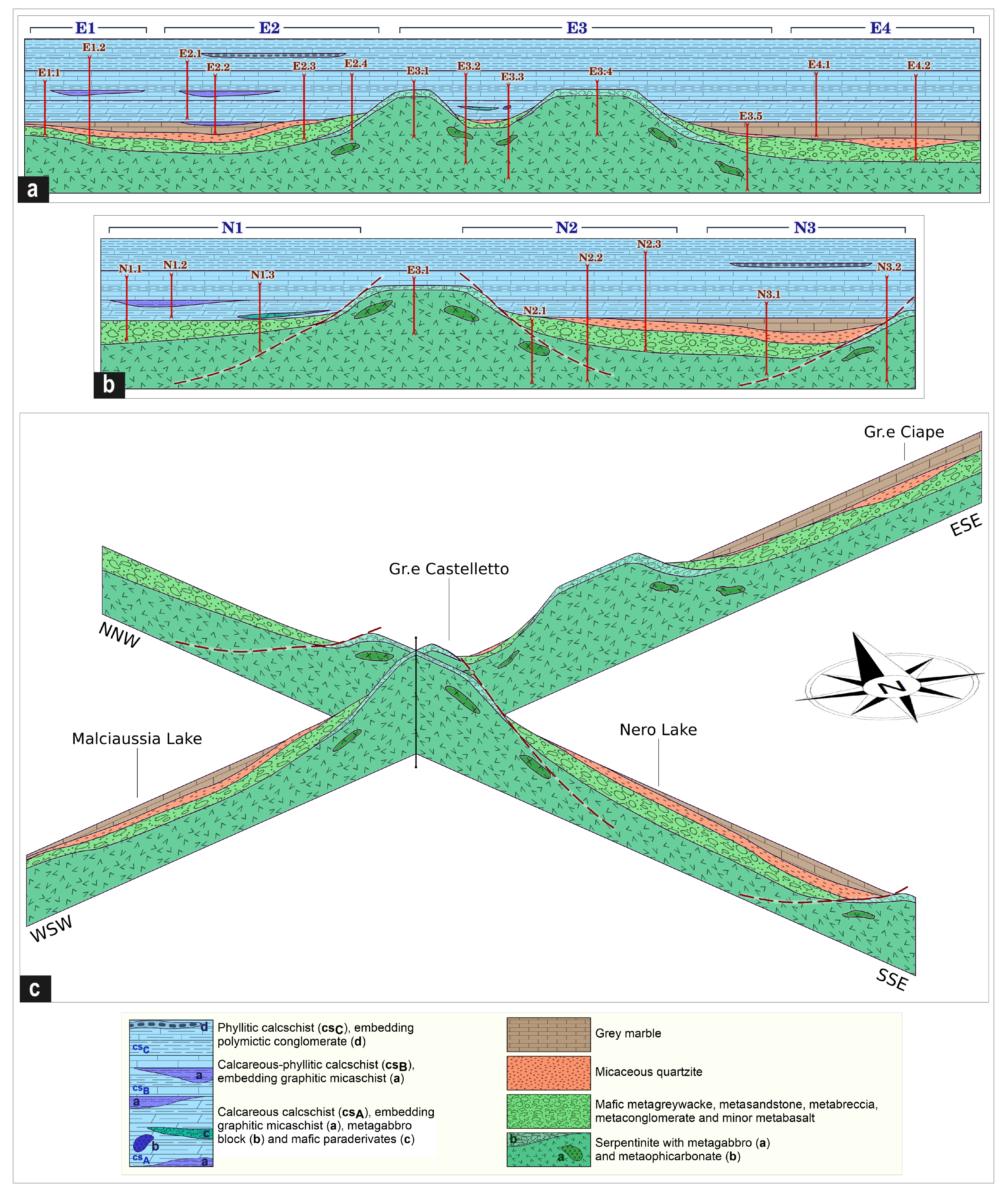
Publisher’s Note: MDPI stays neutral with regard to jurisdictional claims in published maps and institutional affiliations. |
© 2021 by the authors. Licensee MDPI, Basel, Switzerland. This article is an open access article distributed under the terms and conditions of the Creative Commons Attribution (CC BY) license (https://creativecommons.org/licenses/by/4.0/).
Share and Cite
De Togni, M.; Gattiglio, M.; Ghignone, S.; Festa, A. Pre-Alpine Tectono-Stratigraphic Reconstruction of the Jurassic Tethys in the High-Pressure Internal Piedmont Zone (Stura di Viù Valley, Western Alps). Minerals 2021, 11, 361. https://doi.org/10.3390/min11040361
De Togni M, Gattiglio M, Ghignone S, Festa A. Pre-Alpine Tectono-Stratigraphic Reconstruction of the Jurassic Tethys in the High-Pressure Internal Piedmont Zone (Stura di Viù Valley, Western Alps). Minerals. 2021; 11(4):361. https://doi.org/10.3390/min11040361
Chicago/Turabian StyleDe Togni, Marcello, Marco Gattiglio, Stefano Ghignone, and Andrea Festa. 2021. "Pre-Alpine Tectono-Stratigraphic Reconstruction of the Jurassic Tethys in the High-Pressure Internal Piedmont Zone (Stura di Viù Valley, Western Alps)" Minerals 11, no. 4: 361. https://doi.org/10.3390/min11040361
APA StyleDe Togni, M., Gattiglio, M., Ghignone, S., & Festa, A. (2021). Pre-Alpine Tectono-Stratigraphic Reconstruction of the Jurassic Tethys in the High-Pressure Internal Piedmont Zone (Stura di Viù Valley, Western Alps). Minerals, 11(4), 361. https://doi.org/10.3390/min11040361





